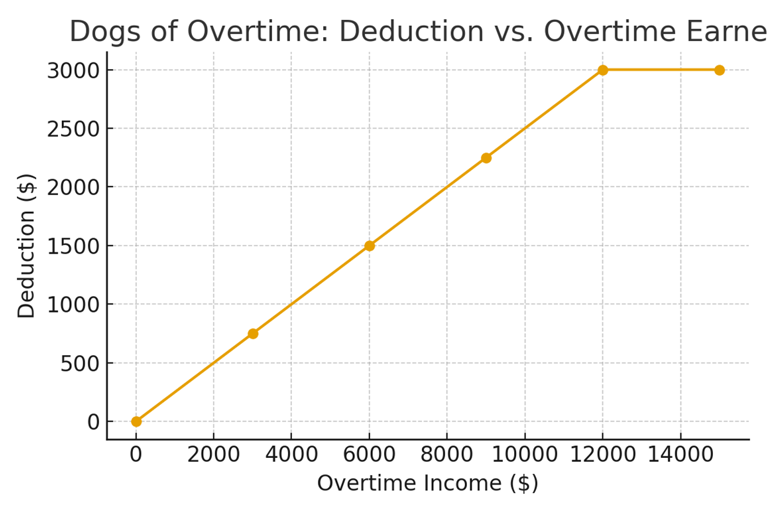Challenges of Overtime Tax Break
Overtime isn’t just more hours—it’s missed dinners, late-night commutes, and the physical wear that comes from pushing past a normal workday.
T. Brown
7/9/20254 min read


For years, the tax code treated those extra dollars exactly like base pay. In 2025, the so‑called “Dogs of Overtime” tax break changed that calculation by letting eligible workers deduct 25% of up to $12,000 of overtime income. In plain English: if you earned overtime, a slice of those earnings now gets special treatment on your tax return.
As a commentary, I think this is overdue. Overtime is rarely optional in the sectors that rely on it—healthcare, logistics, hospitality, public safety, and retail. It’s often the difference between a facility running smoothly and a shift falling apart. Recognizing that reality with targeted tax relief sends a message: your extra time has extra value.
What the Rule Does (and Who Qualifies)
The provision allows a deduction equal to 25% of overtime earnings, capped at $12,000 of overtime per taxpayer, per year. That means the maximum deduction is $3,000. The rule applies to employees who are paid overtime under federal or state labor laws—generally, non‑exempt W‑2 workers. If you are salaried and not eligible for overtime under your employer’s policy (or you’re an independent contractor paid on Form 1099), this deduction does not apply to you.
Qualifying overtime must be separately identifiable on pay stubs or payroll records. If your paycheck aggregates all hours into a single line item with no overtime breakout, ask your payroll department to ensure the overtime portion is tracked explicitly; you’ll want that documentation come tax time.
How the Deduction Works (Step by Step)
1) Add up your total overtime wages for the year. Look for the “OT” line or similar code on each pay stub.
2) Apply the annual cap: only the first $12,000 of overtime can be used for this deduction.
3) Multiply by 25%. That result is your deduction. Example: $12,000 × 25% = $3,000. If you had $7,200 of overtime, the deduction is $1,800.
4) Claim it on your return. The deduction is available even if you do not itemize, which makes it broadly accessible.
5) Coordinate with other tax moves. Lowering your adjusted gross income (AGI) can increase other benefits (for example, eligibility for certain credits or deductions that phase out at higher incomes).


Real‑World Scenarios
James, RN in a hospital: Base pay $50,000; overtime $15,000. Only the first $12,000 of overtime counts for the calculation. Deduction = 25% × $12,000 = $3,000. If James is in the 22% federal bracket, that deduction alone may save roughly $660 in federal income tax (plus potential state tax savings). For someone regularly covering short‑staffed shifts, that’s not trivial.
Carla, warehouse associate: Base pay $42,000; overtime $6,400 during peak season. Deduction = 25% × $6,400 = $1,600. Carla uses her tax savings to pad an emergency fund. For hourly workers with volatile schedules, this cushion matters.
Luis, seasonal resort worker: Overtime varies monthly. He tracks overtime on every paycheck, totals it at year‑end, and coordinates the deduction with a higher 401(k) contribution. Lowering AGI through both the overtime deduction and pre‑tax retirement savings can improve eligibility for certain credits.
Planning Opportunities (and Pitfalls)
Opportunities:
• Withholding tune‑up: If overtime is fairly predictable at your job, update your W‑4 so your take‑home pay reflects the new deduction. That reduces the chance of loaning the IRS money interest‑free all year.
• Pair with pre‑tax savings: 401(k), 403(b), or HSA contributions also reduce taxable income. Combining those with the overtime deduction can magnify the effect on your AGI.
• Time your overtime: If your employer lets you choose between late‑December and early‑January overtime, it may be worth forecasting whether the cap will be used this calendar year or next.
Pitfalls:
• The cap is hard: Anything above $12,000 of overtime doesn’t increase the deduction. Expect diminishing returns once you hit the limit.
• Documentation is critical: Keep pay stubs. If audited, you’ll need to show the overtime portion clearly. Your employer’s payroll system is your best ally here.
• State tax mismatch: Some states may not conform to the federal overtime deduction. Check your state’s conformity rules or ask a preparer.
Pros and Cons (Fairness vs. Complexity)
Pros:
Acknowledges the personal and family toll of overtime with tangible relief.
Targets industries where overtime is most common and least optional (healthcare, logistics, public safety).
Available without itemizing, so many more workers benefit.
Cons:
Excludes salaried workers who routinely put in 50–60‑hour weeks without overtime pay.
Adds another moving part to an already complex tax code.
Creates a cliff effect at the $12,000 cap and may not be adopted by every state.
Opinion: Why This Policy Makes Sense
Is this the perfect solution? No. But it is a practical one. A holistic fix would re‑examine how we classify work, compensate extra hours, and ensure equity between hourly and salaried staff. That’s a bigger project. In the meantime, the Dogs of Overtime deduction sends the right signal: time has value beyond dollars and cents. If we want hospitals staffed and supply chains moving, rewarding the people doing the hard, unsocial hours is sensible policy.
For workers, this is permission to run the numbers. If you typically cross the $12,000 overtime mark by October, consider whether additional overtime later in the year still makes sense after taxes—or whether it’s time to take the rest you’ve earned. Smart planning is part financial, part human.
Key Takeaway:
A 25% deduction on up to $12,000 of overtime doesn’t fix everything, but it meaningfully boosts take‑home pay for the people keeping essential sectors running.
Citation
TurboTax. “Tax Reform Updates 2025.” TurboTax. https://turbotax.intuit.com/tax-reform/

